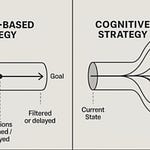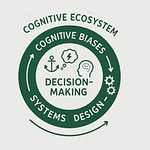Fast decisions in an organization can be the difference between everybody making a lot of money or all of the stakeholders going home crying in an absolute mess every quarter.
But fast decisions—they're not just about form, they're also about function.
And somewhere along the way, and I reckon this has happened in the past 10 to 15 years, we've turned thoughtfulness into an excuse for indecision.
These days, fast decisions feel risky.
Slow ones feel responsible.
And that's because somewhere along the way, we confused delay with diligence.
And it's costing us a mozza.
The Cost of Delay
Big companies waste around 530,000 hours a year aligning decisions.
530,000 hours a year.
Compare that to high-growth companies who are growing at two and a half times faster.
And they do it because they're able to make decisions fast.
But this is not necessarily something that we've got wrong.
This is just how we operate.
Our brains are set up to work this way.
Our brains delay action so that we can simulate outcomes.
And this is really useful for us to find the best way forward.
It served us really well throughout evolution.
But now it's stopping us from moving forward.
Why Speed Requires Trust
What we really need is more speed in these decisions.
But speed builds with trust.
Companies don't move fast not because they don't want to, but because they can't move fast.
They don't have the trust, the infrastructure there to allow these decisions to move at the speed they need to.
So rather than stay competitive, they wait and do nothing.
We say things like, "we’ll circle back on this next month."
And then we forget about it.
And when we come back to it, the opportunity is gone.
The Real Question
The real question isn't “Why are we so slow?”
It's “What becomes possible when we stop waiting and start taking the opportunities in front of us?”
We're not solving for fast decisions.
We're solving for missed opportunities.
Whenever a big decision comes up, it feels like everything slows down.
Not because of doubt.
Not even because we don't know what to do.
But because we've been conditioned to see speed as risky.
In that pause, opportunity slips by—unnoticed.
We don’t talk about the loss, because we were never really in the game.
The Real Cost: Optionality
The problem isn't speed. It's opportunity cost.
Every delay doesn’t just eat time.
It eats value.
When decisions stall, we lose more than time.
We lose optionality.
In complex systems like organizations, optionality is where resilience lives.
That’s where success and adaptability live.
The Information Excuse
A lot of the time, we use information as an excuse:
“We don’t have enough data.”
“Let’s wait and see what the market does.”
But in high-speed environments, it’s not data that counts.
It’s bandwidth.
The capacity to keep moving without overthinking, without clogging the system.
We have the tools—we’re just not conditioned to use them.
We’re Built for Speed
Your brain's ventromedial prefrontal cortex helps you decide quickly and precisely.
It’s kept us alive for thousands of years.
But we’ve lost this skill to keep moving forward.
So what are we missing every time we don’t move?
Speed isn’t the goal.
Capturing opportunity is.
What’s Really Holding Us Back?
We’re built to move faster.
Our brains love quick decisions.
We love new things.
Our tech and tools are ready.
But our systems have been trained to hit pause.
This isn’t about capability.
It’s structural lag.
What we can do is not what we’re allowed to do.
Live Signals, Static Structures
We’re working with live signals in rigid systems.
The data is live.
The tech is there.
But the flow is stuck.
Four out of five executives say they have access to real-time data.
But only one in five actually use it to make decisions.
This isn’t inefficiency—it’s latency by design.
We’re working against how we’re meant to operate.
Delay by Design
Most of the time, we don’t even use the data we have.
It’s just a delay tactic, blocked by approvals, quadruple-checking, and excessive alignment.
In the last decade, getting approval for everyday decisions has gotten slower—by about 30%.
Meanwhile, the time we’re given to make decisions has shrunk by 40%.
We’ve got almost half the time to decide—and we’re taking 30% longer.
That doesn’t work.
Noticing vs. Acting
We know we can go faster.
We just don’t.
We’re faster at noticing what’s happening—slower at acting on it.
The brain is outpacing the org chart.
The brain is wired for speed.
The org chart isn’t.
It’s not a tooling problem.
It’s a permission problem.
We’ve got everything we need—except the freedom to move.
When We Stop Waiting
What happens when we stop waiting?
What happens when we stop chasing the future?
We start to shape it.
Fast doesn’t feel risky anymore.
Fast becomes familiar.
From Panic to Precision
If we want to stop treating fast as fragile, fast decisions need to become the norm.
Not from panic.
From precision.
If we do that, everything changes.
Clarity becomes constant.
Speed isn’t risky.
It’s how things move.
The system doesn’t brace for change—it expects it.
So it moves rhythmically.
Decision-making isn’t a pause point.
It’s embedded in the rhythm of work.
Speed as System
When ambiguity drops, decision-making accelerates.
No bottlenecks—just clarity.
Organizations stop focusing on making decisions.
They become decision-making systems.
From finance to ops, every function runs on shared cognitive infrastructure.
Speed becomes oxygen—not a luxury for elite teams, but something stabilized across the org.
Eliminating Fatigue
Decision fatigue—gone.
Change fatigue—gone.
Work becomes momentum, not a maze.
It pushes us forward, not holds us back.
Global Scale
Now imagine this at global scale.
Trade agreements, political collaborations—finalized in days, not decades.
Speed doesn’t breed chaos—it enables global collaboration.
Delays become liabilities.
Fast becomes confident.
Not ego-driven.
Streamlined through coherence.
Restoring Rhythm
Systems that think well.
Move smoothly.
Let people operate with clarity.
At some point, resistance isn’t about limitations.
It’s about the stories we’ve inherited—and the egos shaping the narrative.
We’ve got the tools.
We’ve got the models.
But we’re stuck in the belief that speed is risky and clarity takes time.
The Shift Has Already Happened
The shift isn’t coming.
It’s already here.
Decision speed isn’t a future vision—it’s current best practice.
Top-tier companies move capital 6x faster.
Resolve issues 45% more efficiently.
The capability already exists.
The Real Blocker
It’s not the tech.
It’s the hesitation to trust it.
AI and neuroadaptive systems are already operating at scale.
No one’s waiting for you to catch up.
They’re already moving forward.
The constraint isn’t in the system.
It’s in the story.
We’re not waiting on systems.
We’re waiting on permission to move.
This Isn’t Disruption
This isn’t disruption.
This is human rhythm—restored to an environment that tried to block it out.
It’s not disruption.
It’s harmony.
It’s not unnatural.
It’s normal.
From Faster to Smarter
The shift from faster to smarter changes everything.
Because remember:
It’s not about speed.
Speed is just the thing before the thing.
This is about possibility capture.
About optionality.
About seizing what others hesitate on.
That’s the biggest competitive advantage—and the biggest missed opportunity.
From Optimizing to Upgrading
You’re not optimizing.
You’re upgrading.
The real question isn’t “How do we go faster?”
It’s “How much do we lose when we don’t move?”
Hesitation costs more than time.
Innovation leverage drops by 65% with delay.
Trust erodes faster than it can be rebuilt.
This isn’t urgency.
It’s alignment.
It’s sensing what matters—and moving when it does.
It’s not about reacting.
It’s about resonating.








Share this post